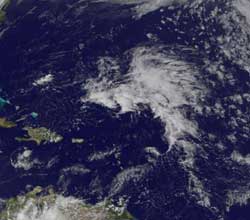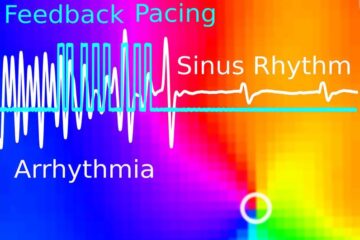GOES-13 sees an extraordinarily early Atlantic low in the tropics

This visible image of the early tropical low several hundred miles north-northeast of Puerto Rico was captured on April 20 at 17:45 UTC (1:45 p.m. EDT) from the GOES-13 satellite. Credit: NOAA/NASA GOES Project<br>
The National Hurricane Center (NHC) issued a Special Tropical Weather Outlook today, April 20, that noted the low pressure area was located about 460 miles northeast of San Juan, Puerto Rico at 3:35 p.m. EDT. The NHC noted that slow development is possible over next couple of days. The low is moving west -northwest at 10mph.
The image was created using satellite imagery was captured on April 20 at 17:45 UTC (1:45 p.m. EDT) from the Geostationary Operational Environmental Satellite (GOES-13). Although it is not easy to pick out the center of circulation in the image, it is located to the west of the largest area of clouds.
GOES satellites are operated by the National Oceanic and Atmospheric Administration. The image was created by NASA's GOES Project, located at NASA's Goddard Space Flight Center, Greenbelt, Md.
The NHC gives this low a 20 percent chance of development into a sub-tropical or tropical storm over the next two days before it hits wind shear, which will weaken it.
Media Contact
More Information:
http://www.nasa.govAll latest news from the category: Earth Sciences
Earth Sciences (also referred to as Geosciences), which deals with basic issues surrounding our planet, plays a vital role in the area of energy and raw materials supply.
Earth Sciences comprises subjects such as geology, geography, geological informatics, paleontology, mineralogy, petrography, crystallography, geophysics, geodesy, glaciology, cartography, photogrammetry, meteorology and seismology, early-warning systems, earthquake research and polar research.
Newest articles

Wildfire danger to increase due to climate change
WSL Institute for Snow and Avalanche Research (SLF) researchers expect an elevated wildfire danger in the Alpine Foreland from 2040 onwards due to changing meteorological conditions. The danger currently remains…

Advanced Brain Science Without Coding Expertise
Researchers at Helmholtz Munich and the LMU University Hospital Munich introduce DELiVR, offering a new AI-based approach to the complex task of brain cell mapping. The deep learning tool democratizes…

Gentle defibrillation for the heart
Using light pulses as a model for electrical defibrillation, Göttingen scientists developed a method to assess and modulate the heart function. The research team from the Max Planck Institute for…





















